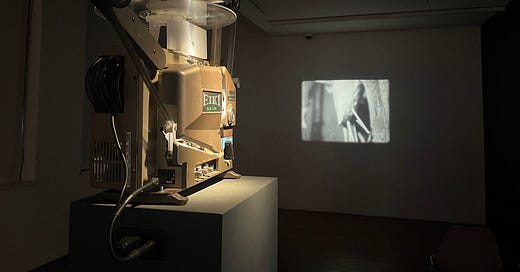On Saturday, John and I went to the Noguchi museum in Long Island City.
It’s a cool place. I might write something at some point about Isamu Noguchi, his sculptures, or my experience with them.
Right now, though, I wanna talk about this thing.
I might be completely wrong. Forgive me, museum curators and other ‘artsy’ people, if there’s some technological utility to this machine that I’m not aware of.
Why use a bulky, archaic machine when its modern equivalent would work just as well?
The answer, of course, is the ‘nostalgia factor.’ The thing looks cool. And it sounds cool—as the video plays, you can hear the fluttering of the film passing through the projector.
One might argue that, in the case of a blockbuster film, being able to hear the film passing through the machine might take away from the experience. But in this particular scenario, the projector became part of the art. This piece of technology was just as much a part of the experience as the film that was projected onto the wall.
Perhaps even more so. The only pictures we took of the actual projected film were ones in which the projector was the focal point.
We weren’t the only ones who behaved this way. John and I shared a strange, intimate moment with a stranger in which we were all huddled around this thing, trying to get a picture of it without getting one another in the frame.
Everyone at this museum came there to look at art, and yet we didn’t have any similar experience of ‘simultaneous photography’ at any sculpture in this place. Why was this piece of intentionally archaic technology so fascinating?
Maybe there’s something awe-inspiring to modern people from the ‘digital age’ about seeing film being projected mechanically. Maybe it’s eye-opening to see the process that goes into projecting film. Maybe, standing there, we suddenly realized how much about modern technology we take for granted.
No. That’s not it.
The reason why we liked this projector was because it was attractive.
Imagine if the projector were ugly. Imagine if it were just a plain, unassuming, flat metal box. Exactly like a modern projector, only with a reel of film sticking out of it. Would anyone be taking pictures of it? Of course not.
It’s a way to glamorize the past. We weren’t drawn to this projector because it was old. We were drawn to it because it was visually appealing. This alone allowed us the self-indulgence of pondering, “Wouldn’t the world be so much better if we still had these projectors, instead of everything being digital?”
Of course, bulky film projectors weren’t ‘works of art’ in the past. They were necessary nuisances that got in the way, just like a plain ol’ digital projector would be today.
Maybe this speaks to the meaning of art in the first place. Art is an indulgence. Utility is just that—utility. Art is taking the ordinariness of life and making it, well, extraordinary.
The choice to use this cool, ‘vintage-inspired’ projector was an artistic choice, and a successful one, judging by the reactions to it.
Or maybe it was just a dumb film projector in an art museum.
Beauty is in the eye of the beholder, after all.






